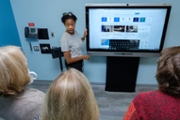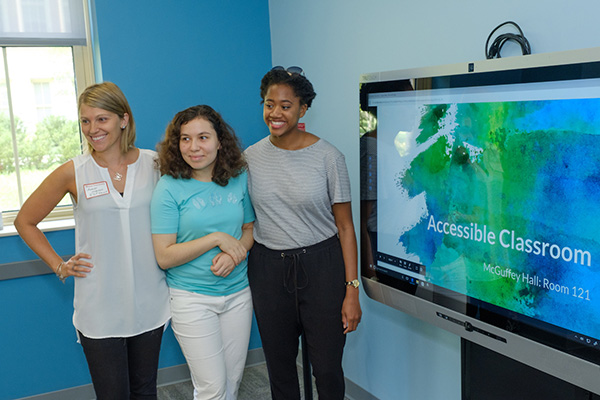McGuffey's universally designed classroom provides inclusion and accessibility for all


By James M. Loy, Miami University's College of Education, Health, and Society
At first glance, the classroom looks almost like any other. There are four walls, desks and chairs, a row of windows, and a white board up front.
But look closer.
And you’ll see that this particular classroom involves so much more.
Watch and listen as the students from this year's Inclusive University Program talk about their process of designing the accessible classroom.
This new space is called the “Accessible Classroom,” and it reflects many of the progressive changes sweeping across Miami University, its College of Education, Health and Society (EHS), and even the wider local community.
“It’s our culminating prototype classroom,” says Ashley Johnson, clinical faculty in special education and the co-coordinator of disabilities studies.
And its innovative and universal design exemplifies the work of Miami’s disabilities studies students and Inclusive University Program participants, who are not only learning how to thrive in the world, they are learning how to actively transform it.
Accessibility has many meanings
“There are a lot of different pieces to accessibility,” Johnson says, “It is not just making sure that wheelchair users can come into a space. There are a lot of subtle things.”
Housed in McGuffey Hall, but available to all professors and students across campus who can request the room through Student Disability Services, the Accessible Classroom features automatic push button doors and a touch teaching station that eliminates a traditional standing podium.
Every light switch, computer port, power terminal, and even window shade drawstring is situated at an accessible height, and other features also support individuals with various sensory disabilities.
The harsh fluorescents, for example, were replaced with softer lighting and adjustable dimmers. The room is also covered in a soothing blue hue that creates a sense of calming seamlessness, which is further enhanced by a transparent glare reducing film that allows one to write directly on the walls.

A special "write on wall" helps reduce glare.
“We have a large population in our student body who identify with disability and some of them are physical disabilities that you might notice, but many of them are invisible,” says Johnson. “So all of these subtle things can really make a significant difference. And a lot of students with disabilities don’t necessarily disclose that disability. So the ultimate goal is that this space is as accessible as possible.”
Here, even the furniture rocks and swivels to accommodate students who may need constant movement, and a few standing desks help others stay focused as well.
And these changes are just the beginning.
Recently, IT Services also awarded the project a Student Tech Fee grant totaling approximately $35,000, which will be used to integrate another wave of assistive technologies later this fall.
“We have a really comprehensive list of technology that we are going to bring into this classroom,” Johnson says. “There will be an Amazon Echo so whoever is instructing or doing a presentation can dictate how the other technology is going to be used. And then there will be lots of assistive technologies that students can use for taking notes and more.”
Initially, it was the Inclusive University Program participants and Miami students themselves who took the lead on writing the Student Tech Fee grant. And, in many ways, even the existence of the Accessible Classroom itself was only made possible because of their persistent efforts to make the campus and the community more accessible.

The students from Miami’s disabilities studies students and Inclusive University Program participants grin for the camera.
Toward a more inclusive campus, community, and culture
An immersive week-long summer course that invites participants with intellectual disabilities to work alongside Miami students, the Inclusive University Program helps those with disabilities gain increased access to higher education. For the entire week, they live on campus, study on campus, enjoy various activities, and build relationships with both their college mentors and each other.
“The program aims to have the experience in the classroom, but also outside the classroom, the social experience that you would have in college,” says Anna Hill, Miami special education major. “It is meaningful for all the participants, both the college students and the participants with disabilities, to be experiencing new things, being alongside a diverse range of peers, and learning from each other.”

Ashley Johnson and two of her EHS students proudly stand next to the new computer station.
Part of their coursework also involves learning about disability as a social construction and then learning how to use that knowledge to identify and make changes to the surrounding physical environment. Johnson calls these “action projects,” and they have already led a number of tangible improvements.
“The administrators have been very receptive to our ideas,” says Victoria Sampson, Miami speech pathology major. “So they have been making changes fairly quickly. I can see the changes that were not there before.”
Some of these action projects, for example, have involved working with Armstrong Student Center administrators to section off accessible dining area seating. Participants have also successfully lobbied to make signage around McGuffey Hall larger and clearer.
Out in the community, they’ve also raised funds to install a wheelchair accessible swing at a local park. And this year, one group developed ideas to make the local parks and rec-based Tri Community Center more inclusive, while another met with Oxford, Ohio, city council members to make universal design improvements to business district sidewalks and communal spaces.
These students are making a real difference, and it’s their laudable level of passion and purpose that’s helping to lead the way.
“We don’t have to change for society, society should change for us,” says Courtney Hineman, one of the 15 participants with disabilities in the Inclusive University Program this year. “Because, we can try, but we can’t change the fact that we have a disability. So society needs to make sure that everyone, no matter what disability they have, can be able to do the things that they want to do.”

